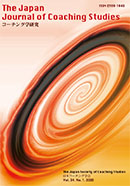Volume 34, Issue 1
Displaying 1-6 of 6 articles from this issue
- |<
- <
- 1
- >
- >|
Special articles
-
2020 Volume 34 Issue 1 Pages 1-13
Published: October 20, 2020
Released on J-STAGE: May 27, 2021
Download PDF (441K)
Original articles
-
2020 Volume 34 Issue 1 Pages 15-33
Published: October 20, 2020
Released on J-STAGE: May 27, 2021
Download PDF (3270K) -
2020 Volume 34 Issue 1 Pages 35-45
Published: October 20, 2020
Released on J-STAGE: May 27, 2021
Download PDF (350K)
Research data
-
2020 Volume 34 Issue 1 Pages 47-60
Published: October 20, 2020
Released on J-STAGE: May 27, 2021
Download PDF (1206K) -
2020 Volume 34 Issue 1 Pages 61-71
Published: October 20, 2020
Released on J-STAGE: May 27, 2021
Download PDF (618K)
Case report
-
2020 Volume 34 Issue 1 Pages 73-84
Published: October 20, 2020
Released on J-STAGE: May 27, 2021
Download PDF (1145K)
- |<
- <
- 1
- >
- >|
